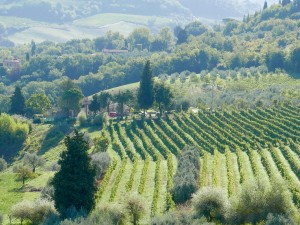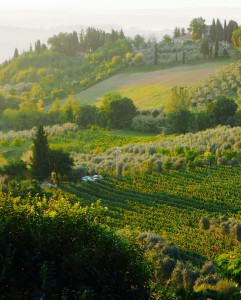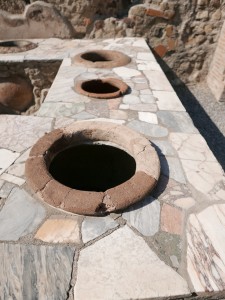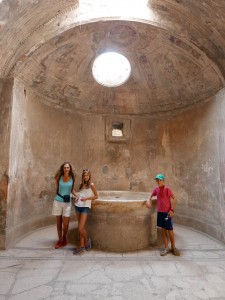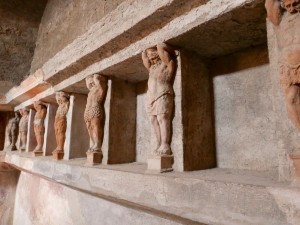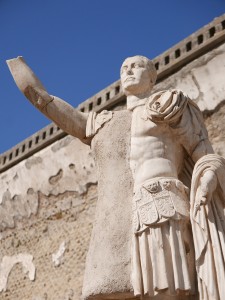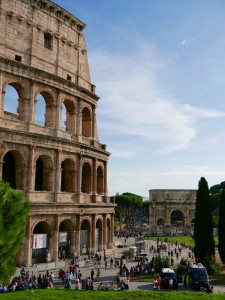According to the legend, Rome was created by the sons of Mars And princess Rhea Silvia. Their uncle was jealous of them so he asked his servants to thrown the twins in the river Tibre. The servants just abandoned them on the shores. They were adapted by a she wolf (now the wolf is the symbol of Rome). They decided to build a town where they were saved, but they fought for who would be the ruler of the city. Romulus killed Remus in the fight, and he became the first ruler of Rome in the 8th century B.C. Rome had a strategic location built around 7 hills, close to the sea and the Tibre river running through it. It helped for its expansion via commerce.
Rome est née avec la légende de Romus et Romulus, les enfants du Dieu Mars et de la princesse Rhea Silvia. Leur oncle jaloux demanda à ses serviteurs de tuer les enfants, mais ils ne firent que les abandonner. Ils furent recueillis par une louve qui les allaita. Le symbole de Rome est la louve allaitant les jumeaux. Ayant grandis les jumeaux se disputèrent pour savoir lequel des deux serait le chef de Rome. Romulus gagna et tua son frère. La ville est située autour de 7 collines et elle est traversée par un fleuve le Tibre, elle a prospéré grâce au commerce.
Life:The agricultural work was very important but hard since the tools weren’t the best. The farmers had slaves to help. Animals were very important to the Romans with cows, bulls, horses, sheep and goats consider as animals of trade. Sheep produced wool and meat. They also produced wine. As the empire extended with conquest of Egypt and North Africa, the farmers had a hard time selling their crops. They were not competitive enough and they’re forced to sell their land and move into town.
La vie courante: L’agriculture détenait une grande place dans la vie Romaine, c’était un travail difficile car ils n’avaient pas de très bons outils. Mais souvent les propriétaires avaient des esclaves pour les aider. Dans les fermes on trouvait des vaches, des taureaux, des chevaux, des moutons et même des chèvres. Les moutons produisaient de la laine et de la viande, ils avaient aussi des vignes. L’empire Romain s’agrandit avec les conquêtes de l’Egypte et de l’Afrique du Nord, ils ramenèrent du blé de ces pays. Les fermiers Romains n’arrivèrent plus à vendre leur récolte, et furent obligés de vendre leurs terres et de partir dans les villes.
Rome became the center of the Roman world. In 200 B.C Rome multiplied its population by 5 to reach 1,000,000. As the population grew they started to live in in houses called insulae’s (sort of taller building). People that lived in insulaes had light with oil lamps and cooked on stoves that were heated with charcoal, but had to go to a water fountain to get water. Although people could cook most ate at taverns or thermopoliae, a sort of snack bar. They mainly eat food they produce like breads, olives, beans, lentils, and a little bit of meat. Under the Empire they organized food distributions for the poor people. People had to use public bathrooms, they sat together side by side without separation, to wipe you had to use a stick with a sponge at the end when you were done you put it in a liquid that cleans it.
There are 2 important parts of every Roman’s life: the city and the familia. The familia means more than just family but every one that lives in the house, as well as slaves that have pleased their masters and earned their freedom. When a new baby is born, they put it at the feet of his father. If he does not pick the baby up it will be abandoned in the streets to be adopted by a citizen. Traditionally children are educated by their mothers until they’re 7. At this time for the real education, the girls learn from their mothers to take care of the house (even if slaves do most of the work), they learned to read, write, and count. The boys have a tutor that teach them to read, write, etc. Each year on March 17th, citizens celebrated a boys turning 17, a time of manhood, giving them the rights as a Roman adult, including the right to vote. They made a sacrifice to the gods offering the bulla (a necklace given at birth that brings luck) and their baby toga to the house gods. Girls can get married at age 12, and boys at age 14. On the wedding day the 2 family’s come together to make sacrifices to the gods. The life of women are always under the authority of a man like their dad, their brother, their husband, but it’s her who commands the house. She’s the one who controls the slave’s.
Il ya 2 choses très importantes dans la vie des Romains : La ville et la famille. La famille est un terme plus large, elle englobe tous les gens habitant dans la maison, même les esclaves. Quand un nouvel enfant naissait, le nouveau né était déposé aux pieds du père et si le père ne le prenait pas dans ses bras, l’enfant était abandonné dans la rue où il serait sûrement adopté par un citoyen. En général, les mères élèvent leurs enfants jusqu’à l’âge de 7 ans. Après, les filles restent avec les mères pour apprendre à s’occuper de la maison (souvent aidées par les esclaves), elles apprennent à lire, écrire et compter. Les garçons ont un tuteur qui leur apprend à lire, écrire, et compter. Le 17 mars de chaque année les citoyens fêtent les garçons qui atteignent 17 ans, ils sont alors considérés comme des hommes, ils peuvent voter. Ils offrent leur Bulla en sacrifice aux Dieux(le collier qui est offert aux enfants quand ils naissent, qui est considéré comme un porte bonheur) et leur toge d’enfant. Les filles peuvent être mariées dès l’âge de 12 ans et les garçons dès 14 ans. Lors d’un mariage les deux familles font des offrandes aux Dieux. Les femmes sont sous l’influence d’un homme, soit leur mari, leur frère etc mais ce sont elles qui dirigent la maison et les esclaves.
The games were a big part in the Roman life, they were bloody and cruel. The more the empire prospered the bigger the games. If the people were not in the baths they went to the games in the afternoon. They were following a religious ceremony (at 1 point they counted up to 175 a year). Examples of the games are the Chariot races or Gladiator fights. They used captured men from a battle and put them in the arena with no weapons and lions, the prisoners were doomed to die. The Emperor often came to the games.
Pour se divertir les Romains vont aux jeux dans les stades (colisée) . Ils adorent les courses de chariots, mais plus encore les combats de gladiateurs. Plus l’empire grandissait plus les jeux étaient fastueux. Les cérémonies religieuses étaient suivies par les jeux, une année on dénombra jusqu’à 175 jeux. Les gladiateurs étaient souvent des esclaves capturés, ils devaient se battre jusqu’à la mort, parfois sans armes contre des lions. L’empereur aimait assister à ses jeux.
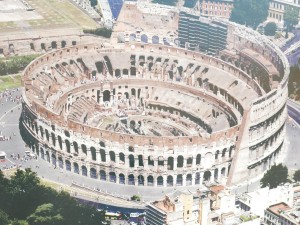
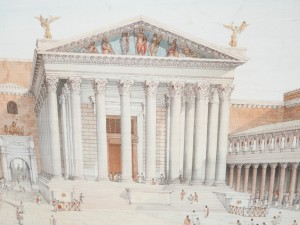
They also spent the afternoon at the baths, it was free, men and women were separated. They enjoyed saunas, cold baths, massages, and being waxed by the slaves. The saunas were heated by underground fires kept by the slaves.
Les Romains passaient de long moments dans les termes (ou bains), c’était gratuit, et un endroit pour discuter. Il y avait des saunas, des bains d’eaux froides, les esclaves faisaient des massages ou des épilations. Il y avait un sytème de chaudière pour chauffer les saunas.
The politics of Rome: In the 1st century B.C the Roman Republic was weakened by conflicts between generals like Julius Cesar and Pompee, as a result the Roman Republic came to an end in 27 B.C. Octavius created an army under the Republic to over throw General Antonius. Octavius succeeded and made Rome an Empire. The power of the Emperor takes all power from the citizens, he chooses the magistrates, senators, creates the rules that senators must approve of, and he is the chief of the army. The Roman Empire ended in the 3rd century A.D. because it was gravely weakened by politic conflicts. The Empire split in 2 in 395, one Emperor ruled the West and the other Emperor ruled the East (Constantinople). Barbarians coming from Germany slowly invaded the Roman Empire of the east. The West Empire ended in 476 when the 10 month reign of 14 year old Emperor Romulus Augustus was overtaken by the Herules, a Barbarian tribe. The East Roman Empire lasted much longer until 1453 when it was invaded and conquered by the Ottomans. The end of the Roman Empire.
La politique: Au 1er siècle AC, la République Romaine fût affaiblie par des conflits entre généraux (Jules César et Pompée par example). Elle s’effondra en 27 AC.sous l’armée d’Octave, vainqueur il créa l’empire Romain. L’empereur se retrouve avec tous les pouvoirs, et les citoyens n’en n’ont plus. L’empereur devient le chef des armées, c’est lui qui choisit les magistrats, les sénateurs, il crée les lois qui seront approuvées par les sénateurs. L’empire Romain prit fin au 3eme siècle après des luttes de pouvoir. Il fût partagé en 2 en 395, une partie ouest (Rome) et une partie occidentale (Constantinople ou Istanbul maintenant). La partie ouest fût envahie par les Barbares venus d’Allemagne et finit par capituler en 476. La partie occidentale dura jusqu’en 1453 quand elle fût envahie par les Ottomans. Ce fût la fin des Romains.
